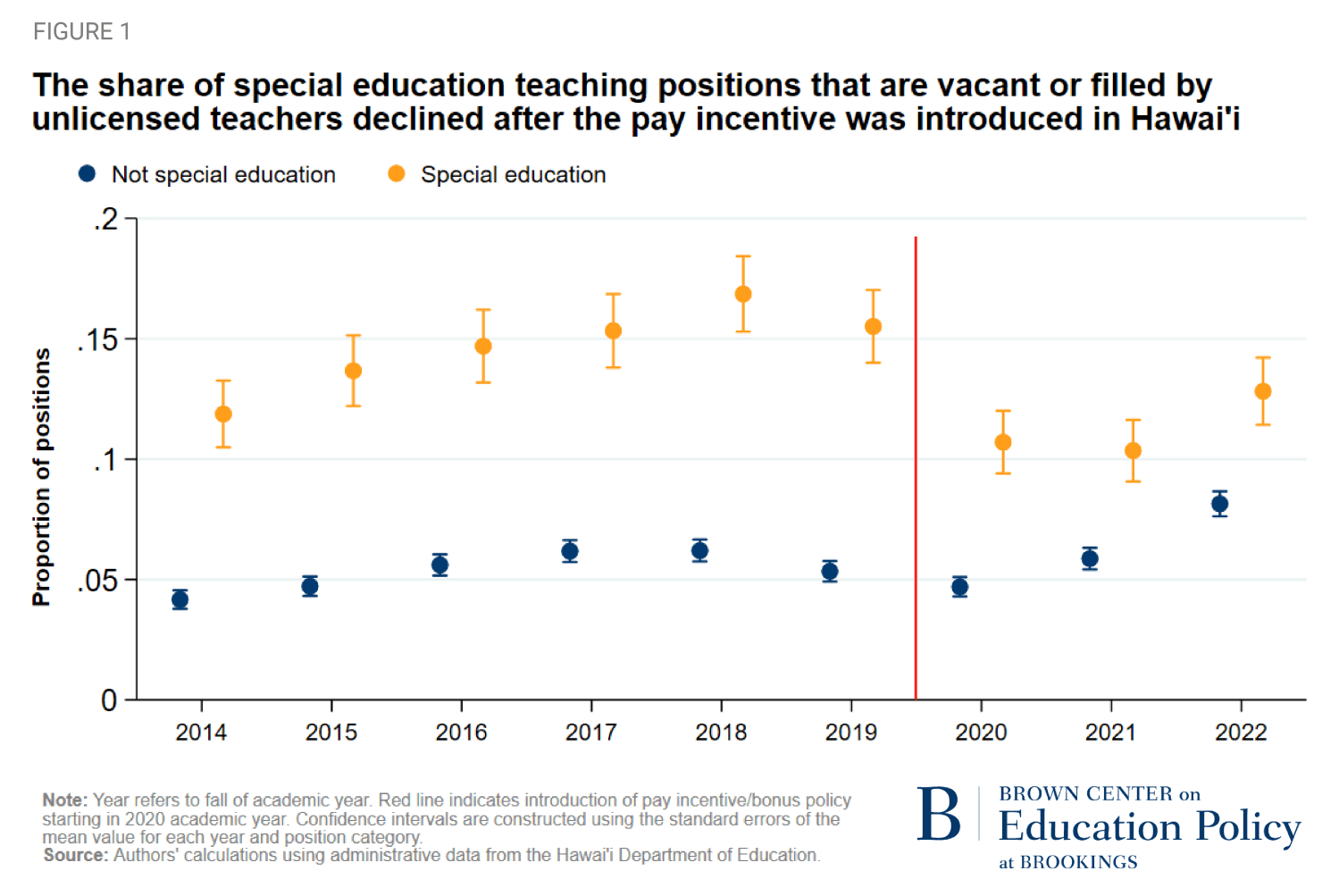Nationwide, schools struggle to fill special education teacher positions, raising concerns about whether schools are adequately staffed to meet the needs of students with disabilities. At the start of the 2023-24 school year, nearly all states reported a large number of unfilled special education teacher positions, and current studies of job postings also show that special educator positions remain open longer, with fewer applicants. Special education teacher staffing challenges pose a serious problem for schools, which are required by federal law to provide students who are eligible for special education with additional instructional services, from a licensed special education teacher. When positions go unfilled, students are less likely to receive services from a qualified teacher, or worse, not receive special education services at all.
Staffing schools with qualified special education teachers has been an enduring challenge, dating back at least to the inception of the Individuals with Disabilities Act in 1975 (IDEA, formerly PL 94-142). There is growing recognition that more needs to be done to increase the number of special education teachers entering the profession, recruit special education teachers to the schools where they are most needed, and retain qualified special education teachers in the profession. States and districts are increasingly implementing new policies that offer financial incentives to special education teachers. Financial incentives include a broad range of strategies that improve special education teacher compensation, including one-time bonuses, to entice teachers to take positions they might not typically accept or remain in a position they might otherwise leave.
Why might financial incentives be a good strategy for special education staffing shortages?
Special education teachers have different, and frequently more difficult, working conditions than other teachers. In addition to directly teaching and supporting students, they have further responsibilities, such as developing and monitoring students’ Individualized Education Programs (IEPs), consulting with general educators, and coordinating supports from related service providers. Their roles also demand additional expertise, as they must ensure students’ access to the general education curriculum while also using specialized methods for intensive intervention, requiring a broader range and depth of curricular and pedagogical content knowledge.
Despite having more extensive responsibilities, special educators often have less support for fulfilling those responsibilities. For example, in a survey of beginning special and general educators in 11 districts, beginning special educators reported more overwhelming workloads, yet they had fewer opportunities to interact with colleagues and mentors on instructional issues. Their ratings of their workloads significantly predicted their intent to leave. Special educators are often the only person in their school serving students with significant support needs, leaving them without colleagues who understand their roles or who can support them in those roles. Further, few school leaders have qualifications in special education. They report struggling to understand special educators’ responsibilities and how to support special education in general.
In addition, working conditions are often more challenging for special educators because school-wide systems and interventions are often designed without consideration for their impacts on students with disabilities and special educators. For example, many states adopted teacher evaluation systems that are misaligned with the best available evidence on effective instruction for students with disabilities, and that do not reflect key aspects of special educators’ roles. Consequently, special educators score significantly lower on these systems than on evaluation systems that are better aligned with effective instruction in special education. Thus, the feedback they obtain through evaluation processes may be less useful for improving their practice. Collectively, these issues leave special educators navigating more challenging responsibilities, with less support.
Despite the additional responsibilities special educators take on, special and general educators typically receive the same pay. Financial incentives may serve as a “compensating differential” for special education teachers’ challenging working conditions, where additional economic benefits are intended to offset, or outweigh, and compensate special educators for their more demanding roles and the additional expertise required to fulfill those roles.
New evidence from Hawai`i’s special education teacher incentive program
Growing research suggests that financial incentives, such as bonuses, may help recruit and retain teachers in hard-to-staff positions. But research has primarily focused on other subject areas, such as STEM and foreign language. It is not clear whether these results generalize to special educators because of their unique job demands.
Recent research from Hawai`i highlights the possibilities of financial incentives to ensure students with disabilities have access to qualified special educators, while also illustrating some limitations of this policy approach. The state introduced a proposal to tackle teacher shortages through pay incentives before the 2019-20 school year. Specifically, special educators’ salaries were raised by $10,000, the salaries of teachers in historically hard-to-staff schools were raised by $3,000-$8,000 (depending on the extent of prior shortages), and the salaries of Hawai`ian language immersion teachers were increased by $8,000. These salary enhancements were additive; for example, a special education teacher in a hard-to-staff school could receive an $18,000 salary bump. We examined the impact of the special education teacher financial incentive program on two measures of special education staffing challenges: (1) the proportion of positions that are completely vacant and (2) the proportion of positions that are either vacant or filled by an unlicensed teacher.
Historically, in Hawai`i, special education teacher positions were nearly three times as likely to be vacant or filled by unlicensed teachers compared to general education positions (see figure 1). But this measure of shortage dropped precipitously after the state introduced its bonus policy in 2020, particularly relative to general education positions. Using “difference-in-differences” models, we found that Hawai`i’s policy reduced the proportion of special education positions that were vacant or filled by an unlicensed teacher by 35%, or 4.0 percentage points. In essence, the policy substantially reduced gaps in access to qualified educators between students who received special education services and students who did not.
Interestingly, the policy did not significantly impact special education teacher retention. Instead, the reduction in special education shortages in the state was almost entirely the result of teachers who were previously in general education positions moving into special education positions after the policy was introduced. This provides compelling evidence that financial incentives can be an effective way to tap into a hidden reserve pool made up of current teachers who could be teaching special education but currently are not.
Are financial incentives enough?
This evidence from Hawai`i suggests that, on the one hand, policies that offer one-time or recurring financial incentives to accept special education teaching positions may be successful at recruiting teachers to vacant positions. Yet, on the other hand, this policy was insufficient to retain those special educators who were already teaching in the state. As such, we do not know whether it will be sufficient to keep new transfers in special education positions over the long term.
Moreover, poor working conditions are a key reason why qualified educators choose not to teach special education and why special educators experience high burnout and choose to leave the profession. At best, financial incentives can only offset the effects of special education teachers’ challenging working conditions. They cannot address the underlying issues that create these conditions in the first place.
No silver bullet
This evidence affirms that financial incentives may be a promising strategy for recruiting teachers to fill special education teacher vacancies. At the same time, financial incentives are unlikely to be a “silver bullet” for addressing special education staffing challenges. Special education teacher staffing challenges include problems related to the supply, recruitment, retention, and equitable distribution of educators among schools. Ensuring that all students with disabilities have access to well-trained, well-supported special educators requires addressing multiple dimensions of the problem simultaneously. This means that states and districts likely need to develop packages of policies, targeted at different dimensions of the problem. For example, policymakers in Georgia are promoting grow-your-own programs to boost supply for new personnel. Simultaneously, they are also strengthening supports for new special educators by providing coaching and virtual training on high-leverage practices to reduce attrition among teachers who disproportionately enter through alternative certification routes.
Multifaceted and well-coordinated solutions, like those Georgia has adopted, are needed to resolve a complex and long-standing problem. Given strong and consistent relationships between special educators’ working conditions and their intent to leave their positions, retaining special educators will likely require improving their working conditions. Assigning more manageable responsibilities and providing stronger supports can make these positions more sustainable for teachers to fill for the long term, reducing the need for financial incentives, to ensure students with disabilities are served by well-qualified, committed special education teachers.
The Brookings Institution is committed to quality, independence, and impact.
We are supported by a diverse array of funders. In line with our values and policies, each Brookings publication represents the sole views of its author(s).












